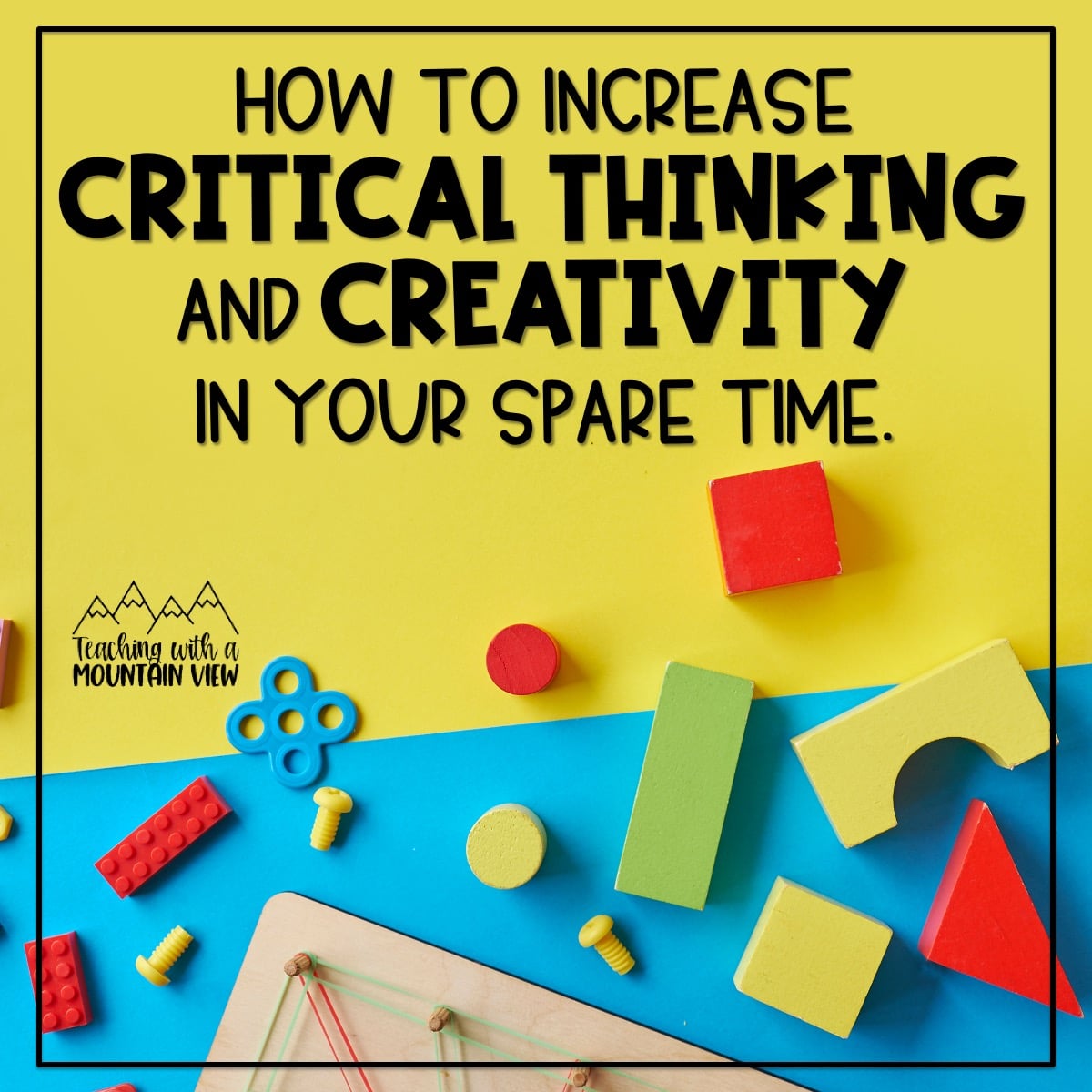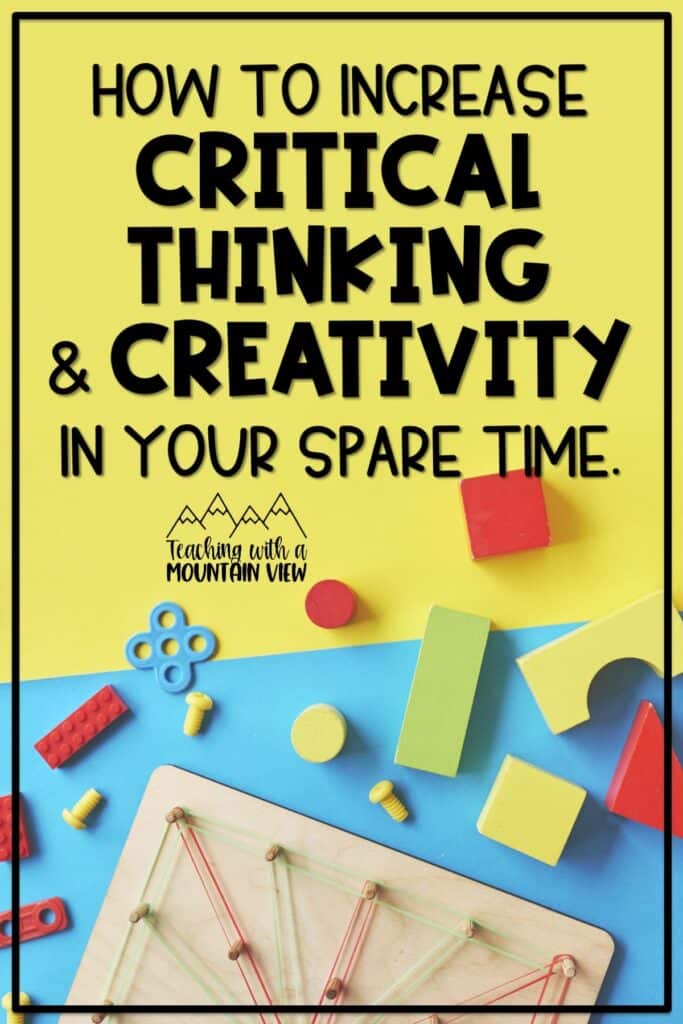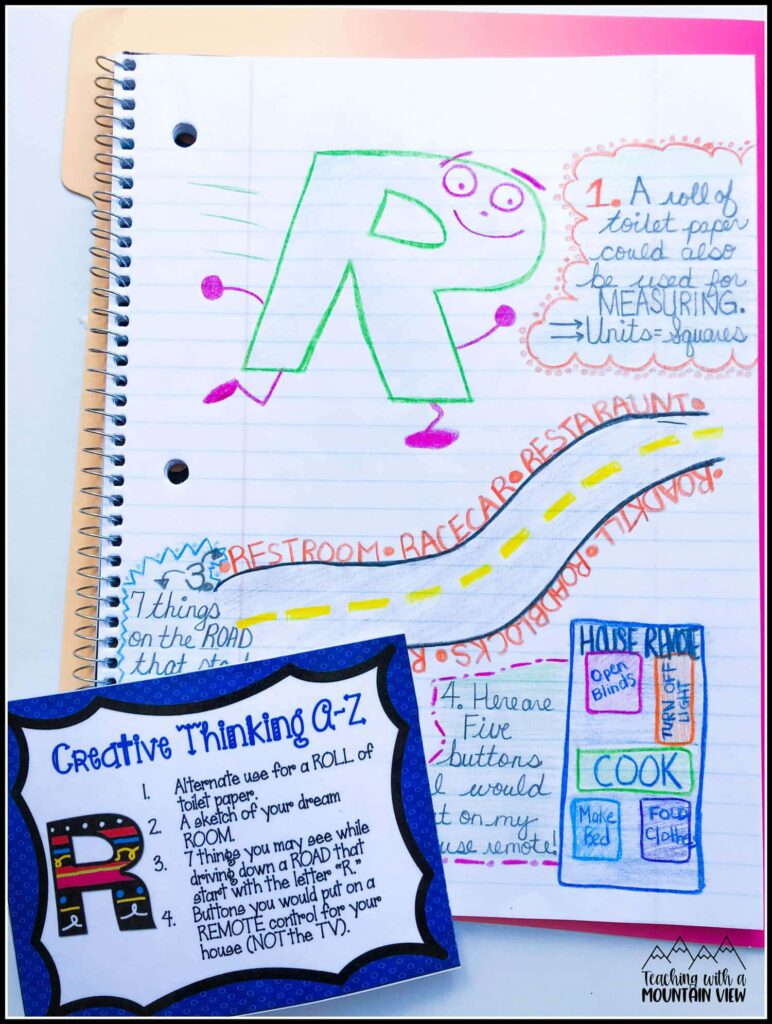How to Increase Critical Thinking and Creativity in your “Spare Time”
By Mary Montero
Share This Post:

We all know that our students need time to cultivate their minds for critical and creative thinking, but knowing how to increase critical thinking can be tricky. I struggle to find time to fit these types of activities in to my daily routine, so I compiled a list of short and snappy (less than 5 minutes, in most cases) activities that get my class THINKING and ENGAGED! Some of these are new and some are old, but perhaps you might pick up a tip to use with your class tomorrow. It’s time to get thinking!

Words Related To…
For this activity, you simply need to choose a word. Any word will do (noun, verb, adjective, really, anything!). Let’s go with the word “dog” for the example. Go around the room and have each student give one word that is related to the selected word. The first few will be highly unoriginal, like bark, leash, bone, etc. but as you get around the room, the “easy” answers will go away, and you might find that some students have to really explain their word choice.
Squiggle De Wiggly
This is, of course, a class favorite, and one that I can keep going for quite some time, even days or weeks if I devote the space to it on my board. One student draws a squiggle on the board to begin. The next student adds on to it to begin to form a discernible picture. The only trick here is that once a student puts the marker (or pencil, or whatever) on the paper, they can’t pick it up until they are done with their part of the drawing.
A Questionable Conversation
My students LOVE this one and it always ends in a fit of giggles. I begin by asking a very general question, like “How was your day today?” They have to answer the question with a question. “How do you think it felt to fall down the slide today?” is one of my all-time favorite responses to that question. You can have each student answer the same question, or you can carry on a conversation with other students. After the slide comment, another student said, “You do know that I broke my leg on a slide last year, right?” This one is best for big kids, since it can get tricky rather quickly.
A School Without… Analogies in Action
You can do this with any topic, but I always start off with “school”. I will start by saying a simple example, like “A school without teachers is like…” And then the students finish the analogy for me. We did this one today, and the first answer was “a hospital without doctors.” Sometimes I have all the students come up with something to finish my analogy, sometimes we make it a chain, where the next person would finish “A hospital without doctors is like…” and it eventually evolves into something completely unrelated to school. I have also had students create their own analogies entirely, giving them only the “A school without….” stem.
The Sounds of School
I like this one because it forces kids to be completely silent, so it’s a great transition activity. The entire room sits completely still, with your door open, and you listen to “the sounds of school.” We do this for 30-40 seconds, and then we share out what we heard. The kids love this, because it’s amazing what you hear when you really listen. When I have a student finish an assignment just a few seconds early, I will say to them, “Sounds of School?” and they know what to do.
Create a Pattern With Your Bodies
This one drives my kids NUTS, and it does take a bit longer than a minute or two. The students have to create a pattern with nothing but themselves. They usually go right to the color of their clothes, and sometimes it works, but they have to figure out the pattern. I once had a class do plain shirts vs. printed shirts, and they had to do an ABBBABBBA pattern because so few students had on printed shirts. They tend to want to sort themselves at first and put themselves in order from tallest to shortest or by their birthday, so I try to clearly explain the difference before they do that. This is hard, but the kids are so invigorated when they finally get it. It’s great for the end of math class.
Categorize Yourselves
This one is similar to the one above, but the students categorize themselves into group, and there can be no “other” group. I often limit the number of groups they can have, too, or put a minimum number of people in each group. They start with the basics, boys/girls, hair color, etc. but then they end up getting incredibly creative.
Inventions That Changed the World Cause and Effect Chain
For this activity, I have one student think of an invention that they believe changed the world. We then create a cause and effect chain going around the classroom. So, the student might start out by saying “sliced bread changed the world.” The next student would say “because without sliced bread, I’d have to cut it myself.” Then maybe something like, “and I don’t have time to cut my own bread in the morning” “so I would end up eating a lunchable instead.” And it goes on and on and on. This is another one that gets hilarious, but I always emphasize that it can’t get too far out into left field. We always end it by saying, “All because nobody invented sliced bread!”
Three Words
I have blogged about Three Words before, where I explained how we use it at the end of the year. I also use this when I have a few extra minutes. Sometimes we keep it simple and do three words about their weekend, their breakfast this morning, their ride to school, etc. But other times we will do something else like “in three words, describe your bedroom.” They can’t use three separate words like “Awesome. Cool. Messy.” It has to form a phrase, for example, “Like a pigsty.”
Creative Thinking Journal
Each of my students also have this creative critical thinking weekly journal, which is perfect for those extra minutes. Each of the 45 sheets begins with a child-friendly quote to interpret. I have found that interpreting quotes challenges students to really think about what they are reading and helps with the tricky skill of inference. The second activity always has something to do with words and vocabulary building, and the third activity varies, but often has some connection to an event or date during that week.
Unusual Uses
Easy, easy. Grab something within reach, and every person has to brainstorm what else it could be used for, other than its actual use.
A rubber band can be a hair tie, a tourniquet (seriously! A student said it!), a slingshot, a bracelet, etc.
Think Tray or Picture
I think I’ve seen something similar to this floating around Pinterest, but I’ve been using it in my room for years. I gather up as many random items as I can, put them on a tray, and put the tray on the document camera for about 30 seconds. If I don’t have time to gather
things up, I simply put a picture up. When the time is up, I cover the tray and the students have to make a list of as many things as they can remember seeing. The person or group that remembers the most wins. If there is a tie, I will ask tie breaking questions, like “what color was the magnet?”
I let them look at this tray for 30 seconds. I had one student remember everything except the magnet. Impressive!

Fluency of Thought, Alphabet Categories, Story Telling
My final activity has to do with fluency of thought. Students are all familiar with fluency in reading, but we need to practice our fluency of thought as well. These types of activities are also great for active listening practice. We practice this by giving the students a letter and a category. For instance, I might say “A” nouns. Then, the students have to go around the room and each give a noun that starts with the letter A. There can’t be more than a two second lag, or our fluency of thought has been broken. They also can’t repeat a noun twice.
We also do this with story telling. I start out a story like, “I couldn’t believe when I opened my door and saw…” and then a student carries on the next sentence or event, leaving off at a crucial point. This requires that students are listening the ENTIRE time and are ready to jump in and contribute to the story telling at any time. Such fun, even if the story only lasts through 10 students.
More Ways to Increase Critical Thinking
I hope you’ve found several new ideas to increase critical thinking and creativity in the upper elementary classroom. This post with creative and educational time fillers has another great list of educational and fun ways to fill those extra five minutes.
Mary Montero
I’m so glad you are here. I’m a current gifted and talented teacher in a small town in Colorado, and I’ve been in education since 2009. My passion (other than my family and cookies) is for making teachers’ lives easier and classrooms more engaging.













